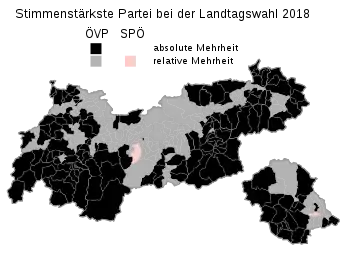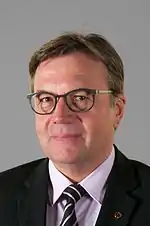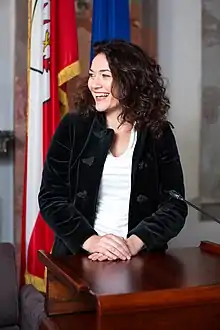2018 Tyrolean state election
The 2018 Tyrolean state election was held on 25 February 2018 to elect the members of the Landtag of Tyrol.
| |||||||||||||||||||||||||||||||||||||||||||||||||||||||||||||||||||||||||||||
All 36 seats in the Landtag of Tyrol 19 seats needed for a majority | |||||||||||||||||||||||||||||||||||||||||||||||||||||||||||||||||||||||||||||
|---|---|---|---|---|---|---|---|---|---|---|---|---|---|---|---|---|---|---|---|---|---|---|---|---|---|---|---|---|---|---|---|---|---|---|---|---|---|---|---|---|---|---|---|---|---|---|---|---|---|---|---|---|---|---|---|---|---|---|---|---|---|---|---|---|---|---|---|---|---|---|---|---|---|---|---|---|---|
| Turnout | 322,379 (60.0%) | ||||||||||||||||||||||||||||||||||||||||||||||||||||||||||||||||||||||||||||
| |||||||||||||||||||||||||||||||||||||||||||||||||||||||||||||||||||||||||||||
 Results by municipality. The lighter shade indicates a plurality; the darker shade indicates a majority. | |||||||||||||||||||||||||||||||||||||||||||||||||||||||||||||||||||||||||||||
| |||||||||||||||||||||||||||||||||||||||||||||||||||||||||||||||||||||||||||||
The conservative Austrian People's Party (ÖVP) placed first with 44.3% of votes, a 4.9 percentage point swing. The centre-left Social Democratic Party of Austria (SPÖ) recovered somewhat from its worst ever result in 2013, rising 3.5 points to 17.2%. The Freedom Party of Austria (FPÖ) also made gains. The Greens took small losses, while Citizens' Forum Tyrol (FRITZ) stayed level. NEOS – The New Austria (NEOS) contested its first state election in Tyrol, debuting at 5.2%. Forward Tyrol, which won 9.5% in 2013, did not contest the election.[1]
Background
In the 2013 election, the ÖVP suffered its worst ever result in a Tyrolean state election, winning just 39.4%; prior to 2008, the party had always held a majority in the Landtag. The party subsequently formed a coalition with the Greens, who had achieved their best ever result in Tyrol at 12.6%.[2]
Electoral system
The 36 seats of the Landtag of Tyrol are elected via open list proportional representation in a two-step process. The seats are distributed between nine multi-member constituencies, corresponding to the districts of Tyrol. For parties to receive any representation in the Landtag, they must either win at least one seat in a constituency directly, or clear a 5 percent state-wide electoral threshold. Seats are distributed in constituencies according to the Hare quota, with any remaining seats allocated using the D'Hondt method at the state level, to ensure overall proportionality between a party's vote share and its share of seats.
Contesting parties
The table below lists parties represented in the previous Landtag.
| Name | Ideology | Leader | 2013 result | |||
|---|---|---|---|---|---|---|
| Votes (%) | Seats | |||||
| ÖVP | Austrian People's Party Österreichische Volkspartei |
Christian democracy | Günther Platter | 39.4% | 16 / 36 | |
| SPÖ | Social Democratic Party of Austria Sozialdemokratische Partei Österreichs |
Social democracy | Elisabeth Blanik | 13.7% | 5 / 36 | |
| GRÜNE | The Greens – The Green Alternative Die Grünen – Die Grüne Alternative |
Green politics | Ingrid Felipe | 12.6% | 5 / 36 | |
| FPÖ | Freedom Party of Austria Freiheitliche Partei Österreichs |
Right-wing populism Euroscepticism |
Markus Abwerzger | 9.3% | 4 / 36 | |
| FRITZ | Citizens' Forum Tyrol Bürgerforum Tirol |
Populism | Andrea Haselwanter-Schneider | 5.6% | 2 / 36 | |
Forward Tyrol, which contested the previous election and won 9.5% of votes and four seats, did not contest the 2018 election.
In addition to the parties already represented in the Landtag, three parties collected enough signatures to be placed on the ballot.
- NEOS – The New Austria (NEOS)
- Family – The Tyrolean Family Party (FAMILY)
- Impulse Tyrol (IMPULS) – on the ballot in all constituencies except Schwaz
Opinion polling
| Polling firm | Fieldwork date | Sample size |
ÖVP | SPÖ | Grüne | Forw. | FPÖ | FRITZ | NEOS | Impuls | Others | Lead |
|---|---|---|---|---|---|---|---|---|---|---|---|---|
| 2018 state election | 25 February 2018 | – | 44.3 | 17.2 | 10.7 | – | 15.5 | 5.5 | 5.2 | 0.5 | 1.1 | 27.1 |
| IFAP | 6–10 Feb 2018 | 600 | 40 | 16 | 12 | – | 17 | 6 | 7 | – | 2 | 23 |
| Research Affairs | December 2017 | 600 | 38 | 14 | 12 | – | 24 | 3 | 5 | – | 4 | 14 |
| GMK | December 2017 | ? | 45 | 12 | 10 | – | 20 | 4 | 6 | 2 | 1 | 25 |
| BrandSupport | June 2017 | 800 | 41.5 | 14 | 15 | – | 16.5 | 4 | 4 | – | 5 | 25.0 |
| Market | May 2017 | 401 | 41 | 13 | 13 | – | 22 | 6 | 4 | – | 1 | 19 |
| Research Affairs | December 2016 | 602 | 33 | 13 | 17 | – | 25 | 3 | 5 | 3 | 1 | 8 |
| IFAP | December 2016 | ? | 41 | 14 | 14 | – | 21 | 4 | 4 | – | 2 | 20 |
| GMK | December 2016 | ? | 41 | 12 | 14 | – | 25 | 3 | 3 | – | 1 | 16 |
| Research Affairs | 28 Nov–9 Dec 2015 | 608 | 35 | 12 | 16 | – | 19 | 5 | 6 | – | 7 | 16 |
| GMK | 7 Nov–11 Dec 2015 | 400 | 38 | 9 | 13 | – | 29 | 4 | 4 | 2 | 1 | 9 |
| GfK | April 2015 | 500 | 39 | 13 | 16 | 1.5 | 13 | 5 | 4 | 1.5 | 7 | 26 |
| GMK | December 2014 | ? | 42 | 17 | 12 | 3 | 15 | 3 | 3 | – | 5 | 25 |
| Gallup | December 2014 | ? | 38 | 15 | 15 | 3 | 13 | 4 | 7 | – | – | 23 |
| GMK | December 2013 | ? | 41 | 11 | 16 | 2 | 15 | 2 | 8 | – | 3 | 25 |
| Karmasin | 22 Nov–11 Dec 2013 | 500 | 41 | 13 | 14 | 6 | 12 | 4 | – | – | 10 | 27 |
| 2013 state election | 28 April 2013 | – | 39.4 | 13.7 | 12.6 | 9.5 | 9.3 | 5.6 | – | – | 9.8 | 25.7 |
Results
 | ||||||
| Party | Votes | % | +/− | Seats | +/− | |
|---|---|---|---|---|---|---|
| Austrian People's Party (ÖVP) | 141,691 | 44.26 | +4.91 | 17 | +1 | |
| Social Democratic Party of Austria (SPÖ) | 55,224 | 17.25 | +3.53 | 6 | +1 | |
| Freedom Party of Austria (FPÖ) | 49,727 | 15.53 | +6.19 | 5 | +1 | |
| The Greens – The Green Alternative (GRÜNE) | 34,167 | 10.67 | –1.92 | 4 | –1 | |
| Citizens' Forum Tyrol (FRITZ) | 17,471 | 5.46 | –0.15 | 2 | ±0 | |
| NEOS – The New Austria (NEOS) | 16,670 | 5.21 | +5.21 | 2 | +2 | |
| Family – The Tyrolean Family Party (FAMILY) | 3,645 | 1.14 | New | 0 | New | |
| Impulse Tyrol (IMPULS) | 1,539 | 0.48 | New | 0 | New | |
| Invalid/blank votes | 2,245 | – | – | – | – | |
| Total | 322,379 | 100 | – | 36 | 0 | |
| Registered voters/turnout | 537,273 | 60.00 | –0.40 | – | – | |
| Source: Tyrolean Government | ||||||
Results by constituency
| Constituency | ÖVP | SPÖ | FPÖ | Grüne | FRITZ | NEOS | Others | Total seats |
Turnout | ||||||
|---|---|---|---|---|---|---|---|---|---|---|---|---|---|---|---|
| % | S | % | S | % | S | % | S | % | S | % | S | % | |||
| Innsbruck City | 25.9 | 1 | 22.8 | 1 | 16.2 | 1 | 19.0 | 1 | 7.9 | 7.3 | 1.0 | 4 | 58.4 | ||
| Imst | 53.1 | 1 | 12.4 | 14.8 | 7.8 | 5.1 | 5.3 | 1.5 | 1 | 60.2 | |||||
| Innsbruck-Land | 39.8 | 3 | 18.8 | 1 | 16.4 | 1 | 11.8 | 1 | 6.6 | 5.5 | 1.2 | 6 | 63.8 | ||
| Kitzbühel | 52.8 | 1 | 14.6 | 14.2 | 8.8 | 4.0 | 4.5 | 1.1 | 1 | 57.7 | |||||
| Kufstein | 44.7 | 2 | 15.3 | 17.5 | 10.2 | 5.3 | 4.2 | 2.7 | 2 | 58.1 | |||||
| Landeck | 63.8 | 1 | 13.1 | 9.4 | 5.4 | 2.6 | 4.8 | 0.8 | 1 | 61.9 | |||||
| Lienz | 49.2 | 1 | 21.9 | 13.3 | 5.5 | 2.8 | 3.7 | 3.4 | 1 | 58.9 | |||||
| Reutte | 49.9 | 13.3 | 14.8 | 8.4 | 3.3 | 6.6 | 3.7 | 0 | 58.6 | ||||||
| Schwaz | 50.8 | 2 | 14.5 | 16.9 | 7.8 | 5.0 | 4.1 | 1.0 | 2 | 58.3 | |||||
| Remaining seats | 5 | 4 | 3 | 2 | 2 | 2 | 18 | ||||||||
| Total | 44.3 | 17 | 17.2 | 6 | 15.5 | 5 | 10.7 | 4 | 5.5 | 2 | 5.2 | 2 | 1.6 | 36 | 60.0 |
| Source: Tyrolean Government | |||||||||||||||
Aftermath
The ÖVP held exploratory discussions with all other parties, narrowing their options to the SPÖ and Greens after the first round of talks.[3][4] On 8 March, Governor Platter announced formal negotiations with the Greens would take place.[5] On 20 March, they announced they had come to a coalition agreement. The government subsequently took office for a second term.[6]
References
- "State results - 2018 Landtag election". Tyrolean Government.
- "New government presents program". ORF. 14 May 2013.
- "Tyrol election: Platter announces exploratory talks". ORF. 26 February 2018.
- "Tyrolean play of colors: Platter plans to continue explorations next week". Der Standard. 1 March 2018.
- "Platter goes into coalition negotiations with the Tyrolean Greens". Der Standard. 8 March 2018.
- "ÖVP and Tyrolean Greens agree". ORF. 20 March 2018.

.jpg.webp)

